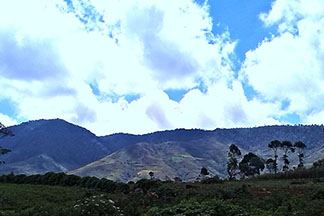 Text by Stephen J Pedroza
Text by Stephen J Pedroza
Photos by Hope Angela Sanico
What happens from the top trickles down.
The wrath of Typhoon Sendong in December 2011 was more than an eye-opener for the people of Northern Mindanao; it has prompted both public and private sectors to craft sustainable and long-term solutions to prevent another severity from reoccurring.
One of the mechanisms being employed at present is the Payment for Ecological Services (PES), an environmental system intended to rehabilitate and preserve the forest resources in the upland areas while the Indigenous People communities will be rewarded for acting as the forest managers.
After its launching on May 21, Xavier Science Foundation (XSF), a non-government organization focusing on agricultural development and research, Xavier University - Research and Social Outreach (XU-RSO), Cagayan de Oro River Basin Management Council (CDORBMC), Department of Environment and Natural Resources - X (DENR) and Mindanao Development Authority (MinDA) Region 10 conducted the first wave of the PES project in Mt Kalatungan Range Natural Park in Talakag, Bukidnon on June 25-27.
PES has been piloted within the ancestral domain of the Miarayon–Lapok–Lirongan–Tinaytayan Tribal Association (MILALITTRA), which is among the 12 IP communities in the protected area of Mt Kalatungan, which prominently stands 2,824m above sea level—known to mountaineers for having the sixth highest peak in the country.
“PES is a strategy designed to protect our forest here in the highlands of Mindanao so that when it rains, the water will not be devastating by the time it reaches urbanized areas like Cagayan de Oro,” said Lordilie Enjambre, development management officer of MinDA-10, the government agency that initiated the project as part of the Mindanao 2020 Peace and Development Framework - MindaNOW! (Nurturing Our Waters) program.
However, Mt Kalatungan faces environmental degradation brought about by illegal logging, hunting of endangered species, socio-economic pressures and other excessive human activities.
In effect, being the catch basin of the waters from the hinterlands of Bukidnon, riverbank communities of CDO would bear massive damage of lives and properties during strong typhoons.
PES encourages various institutions in CDO to take part in a “payment scheme” to ensure the streamlines along the region develop high water infiltration capacity and to provide continuous supply of potable water, clean air and food, among others.
The stepping stone
Mt Kalatungan is among the 18 protected areas to be provided with PES technical and management assistance by different public and private groups.
For the inaugural year, three hectares will be allotted as the “model showcase” of the project.
“Three hectares will serve as the pilot area for PES here; two hectares of which in Sitio Tinaytayan, San Miguel will be allotted for reforestation and one hectare in Barangay Lirongan will be for agroforestry where MILALITTRA plans to grow cacao, coffee and other high-value crops to generate income for the community,” said Stanley Salcedo, XSF program coordinator. XSF acts as the fund manager of the program.
DENR-10 will provide the seedlings while planting and other related activities will begin in the third week of July in the two aforementioned areas.
Moreover, a team from DENR’s protected area supervising unit also conducted an orientation on geotagging using the applications, GPS Status, GeoTag and GeoCam for easy monitoring of the project.
If the model showcase succeeds, PES would entice more industries, investors and even ordinary citizens to support this multi-sectoral endeavor.
From their ancestral domain, the 5-year Community Development Plan (CDP) of MILALITTRA targets to reforest 832 hectares and utilize 816 hectares for agroforestry.
In addition, MILALITTRA dreams to build their tulugan or a sacred place for community dialogues and rituals and to give incentives for the Bantay Lasang volunteers using the income and support to be generated from PES.
Connection with the forest
Harboring diverse species of flora and fauna, Mt Kalatungan was identified as part of a “Terrestrial Biodiversity Corridor” in the Greater Mindanao with “Extremely High Critical” conservation priority.
The forest for the IPs is more than just a mere place of greens and browns. It is a bursting place of life—their ultimate raison d’être why the tribes herein have fostered intimate and protective relationship with the environment.
“We live here. Our ancestors had lived here. All our actions will affect the future generations that is why we need to take care of our forest,” Datu Dungkoan “Rio” Besto of Miarayon said in Bisaya.
They believe that the forest, aside from being their source of livelihood, is an abode of unseen spirits and their ancestors, and the kingdom of their Supreme Being, Magbabaya.
“This is our culture. What is there to life when the forests will be taken away from us,” said Datu Rio, adding that the success of this undertaking lies in the synergy and the genuine concern for the environment among the communities.